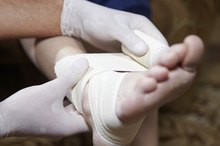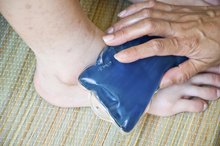Ankle Pain & Swimming
Swimming is a low-impact form of aerobic exercise that is easy on joints. Swimming is often used as a means of rehabilitation for injured athletes and as a means of exercise for those with joint diseases. Athletes who participate in dry-land sports often benefit from the use of water. On the other hand, competitive swimmers can experience persistent ankle pain as the result of repetitive flexing and extending of the ankle 1.
If you are experiencing serious medical symptoms, seek emergency treatment immediately.
Causes of Pain
Ankle pain is most commonly the result of ankle sprains 1. Sprains that are left untreated or repeated ankle sprains can cause ankle instability, which can lead to chronic pain. Ankle pain may also be caused by overuse injuries such as Achilles tendinitis. You may also experience ankle pain as the result of arthritis or a nerve compression -- known as tarsal tunnel syndrome. Poor structural alignment or development of the bones in your feet and legs can also cause pain.
- Ankle pain is most commonly the result of ankle sprains 1.
- Poor structural alignment or development of the bones in your feet and legs can also cause pain.
Benefits of Aquatics
Exercises for Tendonitis of the Foot
Learn More
Since ankle pain most commonly occurs or worsens as the result of participation in weight-bearing activities, doctors and physical therapists often recommend aquatic therapy for rehabilitation from injury or as an alternative for those who suffer from conditions such as arthritis 1. According to the Arthritis Foundation, water exercise can help to keep your joints moving, protect against further damage and allow you to reap the overall health benefits of participation in exercise. The buoyancy of water is beneficial in relieving pain and stiffness in your joints as well as improving circulation and rebuilding strength in your ankle 1.
Swimming Motions
Swimmers use maximum ankle plantar flexion -- the extension of the ankle away from your body -- during competition. Those who participate in the breaststroke aim for maximum dorsiflexion -- the flexing of your ankle so that the angle between your foot and ankle decreases 1. Your ankles are also used heavily when propelling off the walls of a pool or jumping to increase momentum on a diving board.
Tendon Inflammation
How to Swim With Hip Pain
Learn More
Repetitive plantar flexion or dorsiflexion of your ankle can inflame the extensor tendons, which are responsible for the movement of your foot and ankle 1. Pain is usually felt in the ankle and over the top of the tendons while flexing and extending 1. The treatment for this condition includes rest or the application of ice or heat. Consult with your doctor, who may also prescribe an anti-inflammatory medication to alleviate pain. With persistent ankle pain, corticosteroid injections may be used to alleviate pain and inflammation.
- Repetitive plantar flexion or dorsiflexion of your ankle can inflame the extensor tendons, which are responsible for the movement of your foot and ankle 1.
- With persistent ankle pain, corticosteroid injections may be used to alleviate pain and inflammation.
Related Articles
References
- American College of Foot and Ankle Surgeons: Ankle Pain
- American Academy of Orthopaedic Surgeons. OrthoInfo. Achilles Tendinitis. Reviewed June 2010.
- American Academy of Orthopaedic Surgeons. OrthoInfo. Arthritis of the Foot and Ankle. Reviewed March 2015.
- American Academy of Orthopaedic Surgeons. OrthoInfo. Ankle Fractures (Broken Ankle). Reviewed March 2013.
- Arthritis Foundation. Arthritis and Diseases that Affect the Ankle.
- Robati S, Porter K, Shahid M, Crompton T, Sandiford N. Ankle osteomyelitis: an unusual presentation. JRSM Short Rep. 2013;4(6):35. doi:10.1177/2042533313476682.
- Merck Manual Consumer Version. Tarsal Tunnel Syndrome. Revised March 2018.
- U.S. National Library of Medicine. MedlinePlus. Common peroneal nerve dysfunction. Reviewed August 7, 2017.
- Mascard E, Gaspar N, Brugières L, Glorion C, Pannier S, Gomez-brouchet A. Malignant tumours of the foot and ankle. EFORT Open Rev. 2017;2(5):261-271. doi:10.1302/2058-5241.2.160078
- Tiemstra JD. Update on acute ankle sprains. Am Fam Physician. 2012;85(12):1170-6.
- American Academy of Orthopaedic Surgeons. OrthoInfo. Sprained Ankle. Reviewed February 2016.
- Arthritis Foundation. Lab Tests for Diagnosing Ankle Problems.
- Merck Manual. Professional Version. Cellulitis. Reviewed September 2019.
- American Academy of Orthopaedic Surgeons. OrthoInfo. Compartment Syndrome. Reviewed October 2009.
- American Academy of Orthopedic Surgeons. (n.d.). Arthritis of the Foot and Ankle.
- American Academy of Orthopedic Surgeons. (n.d.). Sprained Ankle.
- Koehler SM, Eiff P. (2018). Overview of Ankle Fractures in Adults. Asplund CA, ed. UpToDate. Waltham, MA: UpToDate Inc.
- Mascard E, Gaspar N, Brugieres L, Glorion C, Pannier S, Gomez-Brouchet A. Malignant tumours of the foot and ankle. EFORT Open Rev. 2017 May;2(5):261-71.
- Robati S, Porter K, Shabid M, Crompton T, Sandiford N. Ankle osteomyelitis: An unusual presentation. JRSM Short Rep. 2013 Jun;4(6):35.
Writer Bio
Michelle Zehr started writing professionally in 2009. She has written on health, fitness, fashion, interior design, home decorating,sports and finance for several websites. Zehr possesses a Bachelor of Arts in communication from the University of Pittsburgh, a Master of Arts in professional writing from Chatham University and a graduate certificate in health promotion from California University of Pennsylvania.









